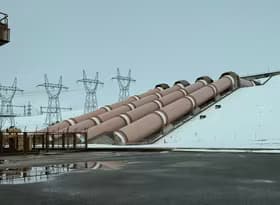
Learning from past population decline
New Zealand experienced record high population growth in 2023, buoyed by record high inflows of migrants. However, migrant inflows have fallen quickly in 2024, and outflows of New Zealand citizens have increased to now-record highs. With regional population estimates for the June 2024 year due next month (October 2024), the challenges of structural ageing and population decline are set to shine through again, and we expect to see areas experiencing slower, and even negative, growth.
This article explores previous periods of population decline – looking at how effective migration is at holding back decline, how we should plan for decline, and what has happened to areas which have experienced population decline in our history.
New Zealand’s population is structurally ageing
New Zealand’s population growth is changing as the population ages. Every region is experiencing structural ageing, where older age groups make up an increasing proportion of the population. Nationally, the population aged 65 years and older is projected to grow from 17% of the population in 2023 to 20% in 2033.
With more older people, and a falling birth rate, New Zealand will experience proportionately fewer births and greater deaths, which slows down natural population growth and makes us increasingly reliant on international net migration to maintain overall population growth.
However, with the same challenge faced around the developed world, we might not be able to count on ever-increasing net migration to fully offset the effect of slowing natural population growth and eventual natural decline. Stats NZ currently projects that natural population growth will fall 36% over the next decade nationally, with sharper increases expected in areas which are at a more advanced stage of structural ageing.
Record migration has slowed, not stopped ageing
Because our population is structurally ageing, migration only slows the ageing process, but doesn’t stop it. To reverse the ageing process, we would need high migration or a dramatic increase in fertility rates, to be sustained for decades in order to counterbalance the continued ageing of the existing population.
Nationally, net migration in 2023 was 2.5 times higher than the average for the prior decade, yet the average age of the population still increased by 0.1 years, slower than the average of 0.2 years per year in the prior decade. Chart 1 breaks down the average age for metro, provincial, and rural areas. Metro areas are appreciably younger, with an average age of 38.3 years in 2023. Record net migration in 2023 helped slow down ageing in metro areas to 0.1 years in 2023, down from 0.2 years in the prior decade.
The population of New Zealand’s rural areas are not only older than metro areas, but are also ageing faster too. The average age across rural areas was 42.5 years in 2023, and had increased 0.2 years in 2023, down from 0.3 years per year in the prior decade. A strong pickup in net migration to rural and provincial areas from 2014 onwards slightly reduced the rate at which these areas were ageing, however, rural areas continued to age much faster than metro areas.
It can be encouraging to see an injection of migration into areas whose populations have languished for some time. However, such injections of migration are rarely enough to reverse population ageing and can therefore falsely encourage a growth-focused mindset, when in fact migration has merely delayed the point at which a population will decline.
A growth-focused mindset is not appropriate for all areas
A growth-focused mindset may be appropriate for our major centres. Take Auckland for example – it has consistently gained a large share of New Zealand’s international net migration, and its relatively youthful population means that the area is projected to have positive natural increase for the foreseeable future. However, looking at our provincial and rural areas, although it is clear that some will continue growing, some equally will face population decline. Accepting decline may seem to run completely counter to the role of local authorities and economic development agencies in promoting their communities, but equally important is the obligation to make decisions with regard to all information available and the community’s long-term best interest.
For those areas facing population decline, the switch to a declining population is unlikely to be quick – so there is no need to rush and make rash decisions now. However, it is important that decisions made today are consistent with expectations for the future. For example, it would be unwise to invest in infrastructure for growth, if growth is not expected, as that could see the costs of under-utilised infrastructure spread across a diminishing population.
Investing to maintain levels of service, or to enhance degraded levels of service, is obviously still critical, and investing well for areas that are still set to grow is crucial too. But recklessly investing in growth everywhere, despite obvious trends towards population decline within the planning window, is not the right outcome.
Population decline doesn’t mean no change
Accepting population decline does not mean doing nothing. The changing nature of our population means that considerable change can be expected even if the headline population doesn’t change, or indeed falls.
Ageing: Ageing of the population leads to fewer children, and more older residents. Growth in older residents can include the ‘young-old’ (who may seek recreational services, or volunteer post-retirement) and ‘old-old’ (who may need advanced care and accessibility features in community facilities). Decline and growth in different demographics could lead to quite different demand for council services and facilities.
Household demand: An ageing population generally leads to smaller household sizes, as a higher proportion of the housing stock is occupied by 1- or 2-person ‘couples without children’ or widow/widower families. In many cases, growth in the housing stock is required even under a flat or declining population as the home occupancy rate falls due to the effects of ageing.
Labour force: People are increasingly working past the age of 65, but everyone retires eventually, so areas with a declining or even flat population can expect a declining labour force. A declining labour force requires either an increase in productivity to provide the same services as before, or a decline in the coverage of goods and services available locally.
All these factors require consideration, and potentially investment, to support the ongoing needs of the local community. At the very least, there’s something to be said about honest communication with the community and businesses so they understand what’s happening, what it means, and what’s being done about it.
Past experiences of population decline
We don’t have to look far to see what population decline looks like. Rapid changes to our economy associated with neoliberal reforms in the 1980s had a profound impact on provincial and rural economies in particular. Economic reform presented challenges for previously protected primary and manufacturing sectors, and corporatisation of major state employers such as the Post Office, Forestry Service, and Railways saw widespread job losses. These effects were particularly acute for small rural centres which were reliant on a single major employer or had limited alternative opportunities, which in many cases led to population exodus. The loss of employment opportunities led to decades of population stagnation and decline for many provincial and rural areas.
Chart 2 shows what has happened to the population of New Zealand’s 16 slowest growing territorial authorities since 1981, expressed as a percentage of their 1981 population. Out of New Zealand’s 66 mainland territorial authorities, 16 had a smaller population in 2023 than they did in 1981. However, 15 of the 16 grew their population over the past decade. Southland District, Invercargill City, Waimate District, and Stratford District had almost recovered to their 1981 population by 2023. Most of the 16 areas managed to arrest their decline by around 2001, and started to grow again from 2014 onwards as net migration flows started to shift away from metro areas towards rural and provincial areas. Deteriorating housing affordability in metro areas, visa settings that encouraged migrants to settle outside the main centres, and the rollout of ultra-fast broadband all likely contributed towards this shift in migration.
Ruapehu District has had the slowest growing population of all areas, falling to 65% of its 1981 population by 2013, and experiencing modest growth to 68% by 2023. Ruapehu experienced a longer and deeper decline than many other areas, and currently faces uncertainty around its future economic outlook, with uncertainty still over its two ski fields on top of recent job losses at the Winstone Industries pulp and wood mills.
It is worth noting that although population decline was in many cases kicked off by single, isolated, events such as mass redundancies, the effect on population is often ongoing – for most of these areas, they experienced a consistent decline over decades. Mackenzie District is a notable exception, as their 1981 population was inflated by crews living in what was then a temporary workers village (Twizel) for construction of the Upper Waitaki Power scheme. Mackenzie’s population dropped 49% between 1981 and 1991 Workers left Twizel once construction was complete, leading to a 49% drop in Mackenzie’s population between 1981 and 1991, with fairly steady growth thereafter.
Areas can still thrive with a smaller population
Losing population may not be a painless process, but that doesn’t mean the future has to be bleak. Many of the communities across New Zealand that have experienced population decline are thriving some 40 years after their declines began, even if some remain smaller overall. Accepting population decline doesn’t mean accepting defeat, in some cases it means making wise decisions for the future.



















